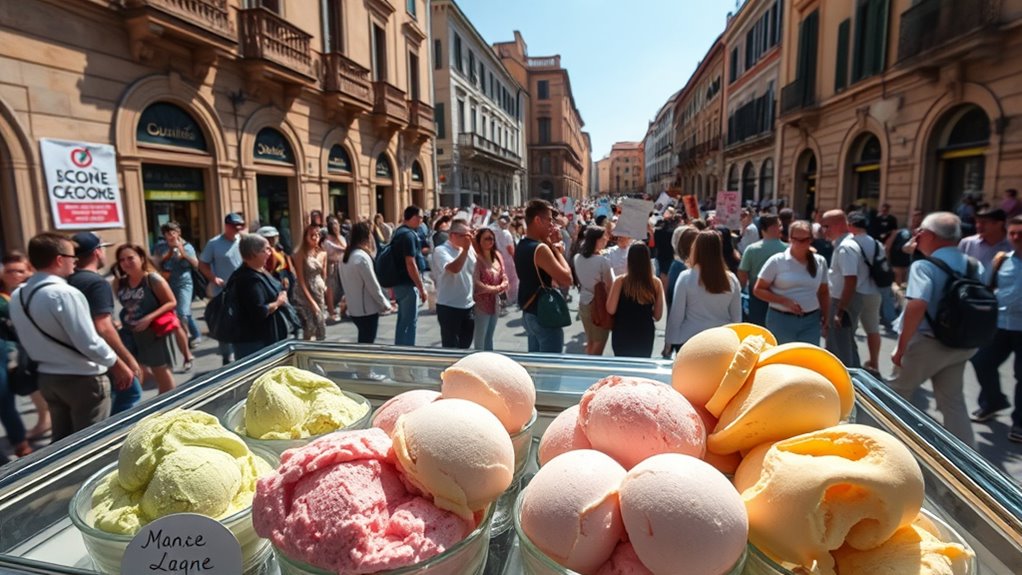In Italy, gelato prices shift based on location, with higher costs in tourist hotspots where shops charge more to attract visitors and maximize profits. Locals often protest these tourist traps, fearing they threaten the traditional, affordable craft of gelato. Factors like ingredient quality, labor, and local economy influence prices too. Want to understand how these dynamics impact the authentic gelato experience? Keep exploring to uncover the full story.
Key Takeaways
- Gelato prices vary based on location, ingredient quality, and operational costs, with tourist hotspots charging premium prices.
- Tourism influx drives shop owners to raise prices, turning gelato into a luxury item and causing local protests.
- Local communities seek to preserve gelato’s cultural authenticity by opposing inflated prices and tourist traps.
- External economic factors like inflation and currency fluctuations influence gelato pricing strategies.
- The industry balances economic sustainability, tourist demand, and cultural integrity, impacting pricing and community relations.

Have you ever wondered how gelato became such an essential part of Italy’s economy? It’s not just a treat for visitors; it’s a thriving industry that supports local businesses and communities. But behind the colorful displays and enticing flavors, there’s a complex web of factors that influence gelato pricing and how tourists impact the market. When you walk into a gelateria, you might notice that prices vary markedly from one shop to another. Some places charge a premium, especially in popular tourist hotspots, while others keep prices more affordable. This variation isn’t random; it reflects the local economy, the quality of ingredients, and the perceived value of the experience. Tourist impact plays a huge role here. In highly trafficked areas, shop owners often raise prices because they know tourists are willing to pay more for a picture-perfect cone. It’s a way to capitalize on the influx of visitors, but it also fuels frustrations among locals who see their beloved gelato becoming a symbol of tourist traps. Locals often protest these inflated prices, arguing that gelato should be accessible and authentic, not a luxury reserved for those willing to spend extra. They worry that the rising prices distort the true cultural value of gelato, turning it into a commodity aimed at tourists rather than a traditional craft. This tension between locals and tourists creates a dynamic where pricing strategies become a reflection of broader economic and social issues. For tourists, it can feel like a gamble—spending more in certain places might guarantee a better experience, but it also risks falling into overpriced traps. Conversely, some shops deliberately keep prices lower to attract locals and savvy visitors who know where to find authentic, reasonably priced gelato. The fluctuation in gelato pricing also ties into the cost of ingredients, labor, and location. A shop in a less touristy area might offer more competitive prices because overhead costs are lower, whereas prime spots near major attractions often charge a premium. Additionally, economic factors like inflation and currency fluctuations can directly influence the cost of ingredients and overall pricing strategies. Ultimately, the pricing of gelato encapsulates a balancing act: shop owners want to sustain their business, tourists seek value, and locals aim to preserve their cultural heritage. The impact of tourism has undeniably shaped the industry, prompting ongoing debates about authenticity, affordability, and economic fairness. As you enjoy your next cone, remember it’s more than just a sweet treat—it’s a reflection of Italy’s economic landscape, shaped by the forces of tourism, local pride, and the timeless art of gelato making.
Frequently Asked Questions
How Do Seasonal Changes Affect Gelato Pricing in Italy?
Seasonal fluctuations markedly impact gelato pricing in Italy by affecting ingredient availability. When certain fruits or nuts are in season, they’re more abundant and affordable, lowering costs. Conversely, off-season ingredients are scarcer and pricier, which raises gelato prices. You’ll notice this variation especially in winter versus summer, as gelato shops adjust their prices based on ingredient costs and seasonal demand, ensuring they stay profitable while offering fresh flavors.
What Role Do Local Ingredients Play in Gelato Cost Differences?
Did you know that gelato made with local ingredients can be up to 30% more expensive? When you choose gelato that prioritizes local sourcing, you’re paying for higher ingredient quality, which often means fresher, more authentic flavors. These local ingredients—like fresh fruit or regional dairy—drive up costs, but they also guarantee a richer taste. So, your choice supports local farmers and gets you a superior gelato experience.
Are There Legal Regulations for Gelato Pricing in Italy?
You’ll find that Italy doesn’t have strict legal regulations for gelato pricing, but there’s a strong emphasis on pricing transparency and consumer protection. Shops are expected to clearly display prices, preventing hidden fees. This helps you make informed choices and avoid tourist traps. While laws aren’t overly restrictive, local authorities focus on fair pricing practices, ensuring you get honest value and can enjoy authentic gelato without the fear of being overcharged.
How Does Branding Influence Gelato Prices in Tourist Areas?
Your gelato’s price can skyrocket because of branding, especially in tourist hotspots. When a shop boasts a strong brand reputation, it signals quality and exclusivity, allowing them to charge more. Marketing strategies like attractive signage and celebrity endorsements make you believe you’re getting a premium experience. As a result, tourists are willing to pay top dollar, fueling the perception that these brands are worth the extra cost, even if the gelato isn’t vastly different.
What Impact Does Import Duty Have on Gelato Ingredient Costs?
Import tariffs directly raise your gelato ingredient costs by making imported items more expensive, which can lead to higher prices for customers. When sourcing ingredients, you’ll find that tariffs on items like cocoa, nuts, or fruit increase expenses, prompting gelato shops to adjust prices accordingly. These import duties influence your overall costs, prompting vendors to pass some of these additional costs onto you, affecting the affordability of authentic, high-quality gelato.
Conclusion
As a visitor, you might notice gelato prices vary greatly across Italy, reflecting factors like location and quality. Fascinatingly, in some tourist hotspots, prices can be twice as high as in local neighborhoods. This disparity highlights how tourism impacts local economies and prices. If you choose to explore lesser-known areas, you’ll likely enjoy authentic gelato at fairer prices, supporting local businesses and experiencing Italy’s true flavors without overspending.









